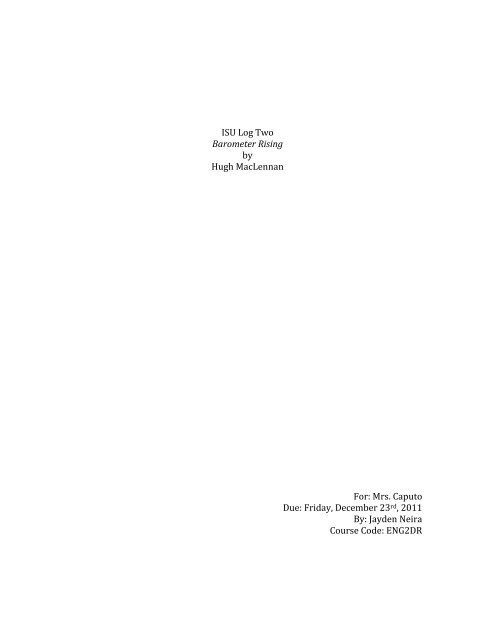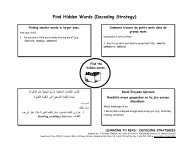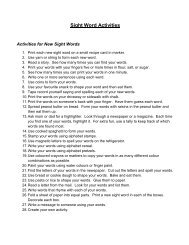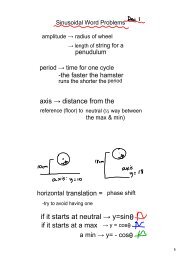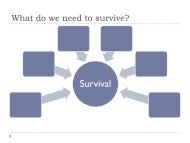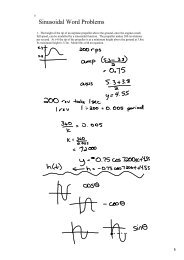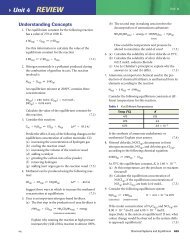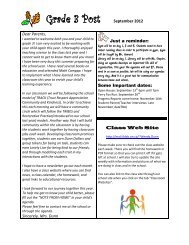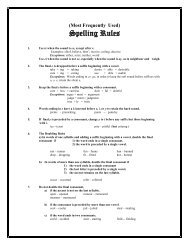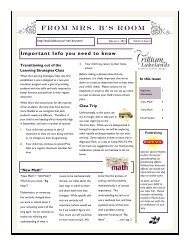ISU Log Two Barometer Rising by Hugh MacLennan For: Mrs ...
ISU Log Two Barometer Rising by Hugh MacLennan For: Mrs ...
ISU Log Two Barometer Rising by Hugh MacLennan For: Mrs ...
You also want an ePaper? Increase the reach of your titles
YUMPU automatically turns print PDFs into web optimized ePapers that Google loves.
<strong>ISU</strong> <strong>Log</strong> <strong>Two</strong><br />
<strong>Barometer</strong> <strong>Rising</strong><br />
<strong>by</strong><br />
<strong>Hugh</strong> <strong>MacLennan</strong><br />
<strong>For</strong>: <strong>Mrs</strong>. Caputo<br />
Due: Friday, December 23 rd , 2011<br />
By: Jayden Neira<br />
Course Code: ENG2DR
Passage One: Page 205<br />
The dinner dishes were washed<br />
and the dish cloths hung against the<br />
copper boiler to dry. Alec was seated<br />
on a wooden chair beside the kitchen<br />
table with his shirt open at the neck,<br />
his shoes off, and his feet in heavy<br />
army socks that made them look like<br />
enormous khaki sponges. A glass<br />
containing a mixture of rum and water<br />
was half-hidden in one of his hands,<br />
but he seemed to have forgotten it was<br />
there, for he had been sitting all of ten<br />
minutes without moving. The stove in<br />
the corner was burning high and all<br />
the windows were shut. The hot air of<br />
the room had an odour of dish-water<br />
and cabbage and the fumes from<br />
Alec’s pipe. Like most poor folk in<br />
northern countries, the MacKenzies<br />
hoarded what warmth they had. The<br />
plastered walls of the kitchen were<br />
bare except for large calendar donated<br />
<strong>by</strong> a grocery store. They were stained<br />
and yellow as naphtha in the glare of<br />
the unshaded lamp which stood in the<br />
center of the table, giving Alec light to<br />
read his paper and enabling Annie his<br />
wife to see the socks she was knitting.<br />
Here we are introduced to a very<br />
important character in the novel<br />
<strong>Barometer</strong> <strong>Rising</strong>, Alec MacKenzie. In<br />
this passage he seems like a very<br />
relaxed person and we are given<br />
enough detail to possibly picture what<br />
he looks like.<br />
This makes the reader wonder what<br />
he is so lost in thought, thinking about<br />
that he hasn’t moved for ten minutes.<br />
We know that Neil is looking for him,<br />
but he does not. We don’t yet know<br />
why Neil is looking for Alec however.<br />
The author uses sensory imagery here<br />
to give us an idea of what Alec’s house<br />
was like. We can picture in our minds<br />
what it looks like, what it feels like and<br />
what it smells like from the way the<br />
author describes it.<br />
We learn that Alec and his family are<br />
very poor, like many of the people in<br />
the north end of Halifax. It also uses a<br />
literary device when it says that they<br />
‘hoarded’ the warmth.<br />
His wife, Annie, is introduced; we also<br />
find out that he has children if we read<br />
a few pages more.
Context:<br />
In this passage we are introduced to a very important person in the novel,<br />
<strong>Barometer</strong> <strong>Rising</strong>. Alec MecKenzie lives in the north side of Halifax, with all of the<br />
poor people and he also work’s for Colonel Wain, Penny’s father. In this passage Alec<br />
is sitting at home with his wife, Annie and their kids.<br />
Before this all we know about Alec MacKenzie is that Neil is looking for him, but<br />
we don’t know why. We don’t know very much about Alec until this point. After this<br />
passage Neil comes to Alec’s house and asks him if he will “testify for [him]” (216)<br />
against Colonel Wain in court and Alec agrees to, even though he knows he will get<br />
fired if he does. We also find out that Alec knew Neil’s father and that they were<br />
very close friends, so Alec like Neil as well.<br />
Significance:<br />
This is significant to the novel because it introduces a very important character in<br />
the novel. Alec MacKenzie is the only person who can testify against Colonel Wain so<br />
that Neil doesn’t get in a lot of trouble, and possibly killed. Alec knows that “it may<br />
mean [he’ll] lose his job” (216) working at the Shipyards for Wain if he does, but he<br />
also knows that it is the right thing to do to help Neil out, so he decides that he will<br />
help him. He also knows that he will most likely not get another job, and defiantly<br />
not one that pays as good as the one he has now. He still is willing to help Neil,<br />
however, even though he is already very poor. This shows what kind of person Alec<br />
is and how he knows what is right and he will do what he knows is right even if it<br />
means putting himself in a difficult situation.
Passage <strong>Two</strong>- Climax:<br />
Page 247-248<br />
The Mont Blanc had become the center<br />
of a static tableau. Her plates began to<br />
glow red and the swollen air inside her<br />
hold heated the cargo rapidly towards the<br />
detonation point. Launches from the<br />
harbour fire department surrounded her<br />
like midges and the water from their<br />
hoses arched up with infinite delicacy as<br />
they curved into the rolling smoke. The<br />
Imo, futile and forgotten, was still trying<br />
to claw her way off the farther shore.<br />
Twenty minutes after the collision there<br />
was no one along the entire waterfront<br />
who was unaware that a ship was on fire<br />
in the harbour. The jetties and docks near<br />
the Narrows were crowded with people<br />
watching the show, and yet no warning of<br />
danger was given. At that particular<br />
moment there was no adequate<br />
centralized authority in Halifax to give a<br />
warning, and the few people who knew<br />
the nature of the Mont Blanc’s cargo had<br />
no means of notifying the town or<br />
spreading the alarm and no comfort<br />
beyond the thought that trinitrotoluol can<br />
stand an almost unlimited heat provided<br />
there is no fulminate or explosive gas to<br />
detonate it.<br />
Bells in the town struck the hour of nine,<br />
and <strong>by</strong> this time nearly all normal activity<br />
along the waterfront had been suspended.<br />
A tug had managed to grapple the Mont<br />
Blanc and was towing her with<br />
imperceptible movement away from the<br />
Shipyards back into the channel of the<br />
Narrows. Bluejackets from the cruiser had<br />
found the bos’n’s ladder left <strong>by</strong> the fleeing<br />
crew, and with flesh shrinking from the<br />
heat, were going over the side. Firelaunches<br />
surrounded her. There was a<br />
static concentration, an intense<br />
expectancy in the faces of the firemen<br />
The Mont Blanc was the ammunition ship<br />
that blew up when the Imo rammed into it<br />
in December of 1917.<br />
This paragraph is very descriptive and<br />
lets us know what is going on with the<br />
Mont Blanc before she blows up. It uses<br />
many different literary devices to<br />
describe what is happening. It uses a<br />
simile to describe the fire harbour as ‘like<br />
midges’ as they are trying to put out the<br />
burning ship. It also has alliteration,<br />
putting emphasis on how the ship, Imo, is<br />
‘futile and forgotten.’ There is also a<br />
metaphor included when it describes the<br />
Imo as ‘claw[ing]’ her way off the shore.<br />
This allows the reader to visualize what<br />
the scene of the burning ship would look<br />
like.<br />
This gives the reader an accurate time<br />
span between the point on which the<br />
Mont Blanc catches on fire and actually<br />
blows up.<br />
This uses suspense to grab the reader’s<br />
attention. We wonder why people are not<br />
running from the harbour and away from<br />
the danger. The author uses dramatic<br />
irony to catch our attention and make us<br />
what to keep reading because we know<br />
that the boat is full of explosives and is<br />
going to blow up but the people in the<br />
novel do not.<br />
This makes us wonder why no one has<br />
warned the people about the ship being<br />
filled with explosives and ammunition<br />
and why the ship crew has ran away<br />
without trying to help any of the other<br />
people and try to get them away from the<br />
danger. This again catches the reader’s<br />
attention and draws us in to keep reading.<br />
This, again, gives the reader an actuate<br />
time of when the events of the day<br />
actually happened.
playing the hoses, a rhythmic<br />
reverberation in the beat of the flames, a<br />
gush from the hose nozzles and a steady<br />
hiss of scalding water. Everything else for<br />
miles around seemed motionless and<br />
silent.<br />
Then a needle of flaming gas, thin as the<br />
mast and of a brilliance unbelievably<br />
intense, shot through the deck of the Mont<br />
Blanc near the funnel and flashed more<br />
than two hundred feet toward the sky.<br />
The firemen were thrown back and their<br />
hoses jumped suddenly out of control and<br />
slashed the air with S-shaped designs.<br />
There were a few helpless shots. Then all<br />
movement and life about the ship were<br />
encompasses in a sound beyond hearing<br />
as the Mont Blanc opened up.<br />
At this point the people the people at the<br />
harbour think that they are safe and that<br />
everything is under control, but the<br />
reader knows that they are not safe and<br />
that the boat is about to explode. The<br />
author uses dramatic irony again to<br />
capture the reader’s interest and<br />
attention.<br />
The end of this passage ends in suspense.<br />
It talks about how the Mont Blanc<br />
exploded and then just stops. This makes<br />
the reader want to continue reading to<br />
find out what happens next, especially to<br />
the people at the harbour. The author<br />
uses suspense to catch the reader’s<br />
attention and draw them in, so they<br />
continue to read the novel.
Context:<br />
During this passage the ammunition boat, Mont Blanc, is still on fire in the water<br />
and the crew has abandoned ship and ran to take cover. None of the people standing<br />
at the harbour watching the burning ship or the people in town know that the ship is<br />
filled with explosives and is going to explode. The fire fighters are trying to put out<br />
the burning ship, but no one is really concerned because they don’t realize the<br />
danger that they are all in. The whole crew had abandoned ship and were “in [a] lifeboat”<br />
(246) heading towards shore and away from the boat, but didn’t bother to tell<br />
anyone about the explosives on it.<br />
Before this Neil visited Alec Macrae’s house and found out that Alec “knew his<br />
father” (226) when barley anyone else did. Neil wanted to ask Alec if he would<br />
“testify for [him]” (216) at court against Colonel Wain, who was Alec’s boss. Alec<br />
however agrees to even if it means that he will lose his job at the Shipyards. Alec<br />
also asks Neil to stay the night and when Neil says no, Alec tells him that his (Neil’s)<br />
father used to all the time and that he was one of his own people, so Neil agrees to.<br />
After this passage, the Mont Blanc blows up and created three forces, “an<br />
earthquake, an air concussion and a tidal wave.” (248) That night there is also one of<br />
the worst snowstorms Halifax had ever seen. The blow from the ship was so strong<br />
that most houses were knocked off of their foundations and almost every house had<br />
the glass broken from the windows. Neil and Murray us the Wain’s house as a make<br />
shift hospital so they can help the injured people because the hospitals were almost<br />
filled to the limit and Murray was a surgeon.<br />
Significance:<br />
This passage is significant because it is the climax of the novel. It is right before the<br />
Mont Blanc blows up and the suspension is very high. It also ends in a very<br />
suspenseful way and makes the reader want to continue reading to find out what<br />
happens next. It also sets up for one of the main themes in the novel, which is that<br />
people change. After the explosion Aunt Maria is much nicer and a lot more willing<br />
to help and even sets up the house to be a makeshift hospital for Murray and Neil.<br />
They believe that Aunt Maria changed because the explosion had been one ting that<br />
she was not able to “bully out of the way.” (284)
Idea One:<br />
“But people do. I’ve seen the war changing them all the time.” (356)<br />
The idea of people changing is a very important theme in the novel <strong>Barometer</strong><br />
<strong>Rising</strong>. The idea of people changing is present in Murray, Penny and Aunt Maria.<br />
Around the middle of the book we find Angus Murray drunk in a bar, telling the<br />
bartender that he “can still operate” (224) and that the “war hasn’t finished [him]<br />
yet.” (224) He is feeling useless at this point and wants to be able to work and help<br />
people. After the explosion happened he had to set up a fake hospital in the Wain’s<br />
house because all of the hospitals were full. This made him feel like he was needed<br />
because “he had performed eleven operations without assistance” (336), which gave<br />
him confidence. Penny has also changed throughout the novel, <strong>Barometer</strong> <strong>Rising</strong>. At<br />
the beginning of the novel Penny did not stand up for herself very much and often<br />
let her family push her around and tell her that she was wrong to be working at the<br />
Shipyards. By the middle of the novel, however, she got more confident in herself<br />
and ended up confronting her father about her seeing Neil and demanded to know if<br />
he was really dead or not. We also hear from Neil numerous times throughout the<br />
novel mentioning how different Penny is now than from the last time he saw her.<br />
Perhaps Aunt Maria was the most changed throughout the novel. At the beginning of<br />
<strong>Barometer</strong> <strong>Rising</strong>, Aunt Maria was very loud and had a big opinion that she liked to<br />
share. She would tell Penny that she should not be working at the Shipyards and<br />
even after the explosion, when Neil and Murray went to the Wain’s house to use it as<br />
a hospital, she told Neil to “stay away from [her]” (272), even though he was just<br />
trying to help. After Murray told her that he needed her help to turn the house into a<br />
hospital she completely changed. She got the whole house organized and even found<br />
Murray a qualified nurse to help him. She even told Murray that she “[had]<br />
confidence in [him]” (284) when he did an operation on Penny. As you can see many<br />
people changed throughout the novel <strong>Barometer</strong> <strong>Rising</strong>, including Murray, Penny<br />
and Aunt Maria.<br />
Reference One- Allusion:<br />
“Roddie soon discovered that members of his aunt’s chapter of the Imperial Order of<br />
the Daughters of the Empire had commandeered the entire house.” (300)<br />
Imperial Order of the Daughters of the Empire:<br />
The Imperial Order of the Daughters of the Empire (or IODE) is national women’s<br />
charitable organization that is dedicated to improve the quality of life for people.<br />
IODE Canada was founded in 1900 to make Canada a better place for all of its<br />
citizens.
This is important in the novel, <strong>Barometer</strong> <strong>Rising</strong>, because Penny’s Aunt Maria is<br />
also part of this organization and this probably explains why she thinks so highly of<br />
herself and why she thinks that she can boss everyone else around. It also confuses<br />
the reader though, because it make us wonder why she doesn’t want Penny to work<br />
at the Shipyards if she is part of an organization that is meant to make Canada a<br />
better place for everyone.<br />
Sources:<br />
http://www.iode.ca/AboutUs.aspx<br />
http://en.wikipedia.org/wiki/Imperial_Order_of_the_Daughters_of_the_Empire<br />
Reference <strong>Two</strong>: Allusion/Reference<br />
“There was now only one vessel moving north towards the upper harbour, the<br />
French munition ship Mont Blanc.” (239)<br />
Mont Blanc:<br />
The Mont Blanc was a French ship that carried general cargo and munitions. She<br />
was 44.8 feet wide, 320 feet long and had a depth of 15.3 feet. The ship was powered<br />
<strong>by</strong> steam and had a gross tonnage of 3121 tonnes.<br />
On December 6 th , 1917 the Mont Blanc was carrying picric acid, gun cotton and<br />
TNT and the top deck carried benzol. The Imo, a Belgian relief vessel, was leaving<br />
Halifax Harbour at the same time that the Mont Blanc was on its way to wait for<br />
convoy. The two ships collided around 8:45 am and the Mont Blanc caught on fire.<br />
<strong>For</strong> twenty minutes people crowed around Halifax Harbour to watch the burning<br />
ship as it drifted towards Pier 6. The crew of the Mont Blanc abandoned ship in<br />
lifeboats to Dartmouth shore and tried to warn people to run.<br />
The Mont Blanc hit Pier 6, setting its wood pilings on fire, and finally, after 20<br />
minuets of burning, exploded. The explosion flattened everything within 800 meters<br />
and caused damage for 1.6 km and cause many fires, which spread quickly.<br />
The explosion caused <strong>by</strong> the Mont Blanc caused more than 1900 deaths, 9000<br />
injured, 1600 buildings destroyed, 12,000 houses damaged, 6000 people homeless<br />
and 25,000 people with inadequate housing.<br />
This is the main event in the novel and everything else in the novel revolves<br />
around this one aspect. The main idea of the book is about the Halifax explosion,<br />
which was caused <strong>by</strong> the ship, Mont Blanc when it crashed into the Imo. In the novel,<br />
<strong>Barometer</strong> <strong>Rising</strong>, it said that the explosion of the ship created three forces<br />
simultaneously; “an earthquake, an air concussion, and a tidal wave.” (248)<br />
Sources:<br />
http://www.halifaxexplosion.org/collision.html<br />
http://canadaonline.about.com/cs/canadaww1/p/halifaxexpl.htm
Reference Three-Reference/Allusion:<br />
Explosives:<br />
“A half-million pounds of trinitrotoluol and twenty-three hundred tons of picric acid<br />
lay there in the darkness under the plates, while the fire above and below the deck<br />
converted the hollow shell of the vessel into a bake-oven.” (245-246)<br />
Trinitrotoluol:<br />
Trinitroltoluol is a yellow coloured solid that is a useful explosive material and<br />
has convenient handling properties. It is the explosive yield of TNT and is<br />
considered the standard measure of strength of bombs and other explosives. TNT<br />
was first prepared <strong>by</strong> a German chemist named Julius Wilbrand in1863 and was<br />
originally used as a yellow dye. It is now used for blasting, and in artillery shells.<br />
Sources:<br />
http://en.wikipedia.org/wiki/Trinitrotoluene<br />
http://www.yourdictionary.com/trinitrotoluol<br />
Picric Acid:<br />
Picric Acid is formally known as 2,4,6-trinitrophenol (TNP). It is a yellow<br />
crystalline solid and is one of the most acidic phenols. Picric Acid is and explosive<br />
and it has a very bitter taste. It is mostly used in munitions and explosives, but also<br />
has some use in the preparation of crystalline salts of organic bases in organic<br />
chemistry.<br />
Sources:<br />
http://www.britannica.com/EBchecked/topic/459542/picric-acid<br />
http://en.wikipedia.org/wiki/Picric_acid<br />
These both connect to the novel, <strong>Barometer</strong> <strong>Rising</strong>, because both of these<br />
explosives where on the ship, Mont Blanc, and caused it to explode because of the<br />
impact when the ship Imo rammed into them. These two explosives are the cause of<br />
the Halifax Explosion, which is the main topic in the novel.
Connections:<br />
I really enjoyed the novel, <strong>Barometer</strong> <strong>Rising</strong> <strong>by</strong> <strong>Hugh</strong> <strong>MacLennan</strong>. It was a very<br />
interesting novel and it was very descriptive about what happened during the<br />
Halifax Explosion. I think that it helped a lot that <strong>MacLennan</strong> had a personal<br />
experience with the explosion and it made the book even better because he could<br />
use so much detail and be very accurate about what time things happened.<br />
At the beginning of the novel, I found it was quit boring because nothing was<br />
really happening and it was more just people talking. Around the middle of the<br />
novel, however, I found it got very interesting and there was a lot more action and<br />
more conflicts between the characters. When the explosion happened it got very<br />
interesting as well and I could hardly put the book down.<br />
Would definitely recommend this as an <strong>ISU</strong> novel for students next semester<br />
because it is very interesting once you get into it and it gives you a lot of information<br />
on the Halifax Explosion. It is also is a fairly easy book to work with when doing an<br />
<strong>ISU</strong> because it as so many different references to use and you can connect to the<br />
novel in many different ways.<br />
Overall, I really enjoyed reading this novel and I found it very interesting and I<br />
learned a lot of things that I never knew before about the Halifax Explosion while<br />
reading it.


